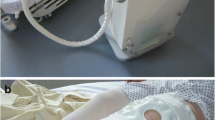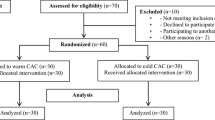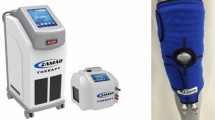Abstract
Background
Cryotherapy has been used to enhance recovery after orthopaedic surgery. Several cooling devices are available but few can guarantee a fixed temperature during a prolonged time and therefore have been criticized. The arrival of new advanced cryotherapy devices made it possible to test the effect of prolonged cooling on rehabilitation after joint replacement.
Questions/purposes
The hypotheses of this randomized controlled trial (RCT) were that advanced cryotherapy devices compared with cold packs result in (1) better postoperative pain control resulting in a lower consumption of narcotics; (2) better early ROM; and (3) less postoperative bleeding and swelling.
Methods
A priori sample size calculation had determined that to detect a difference of 2 points on the VAS, a sample size of 50 subjects per group at followup would be required, given a study power of 80%. One hundred sixteen patients were included and randomly allocated to receive advanced cryotherapy (n = 58) or use of cold packs (n = 58). The primary outcomes for the study were to evaluate pain with the VAS and analgesics consumption. Secondary outcomes were postoperative ROM, swelling, and blood loss. One hundred (50 in each group) patients had complete data available for analysis.
Results
No statistically significant differences in VAS, need for analgesics, nor in secondary outcomes were observed, except for substantially reduced flexion at 6 weeks in the advanced cryotherapy group (114° versus 120°).
Conclusions
Advanced cryotherapy with a continuous temperature for a prolonged period does not deliver expected results of superior early recovery after knee arthroplasty. Greater sample sizes are required to fully determine significant differences between the two techniques for these study parameters. Immobilization of the knee in extension during the prolonged cryotherapy session resulted in lower active flexion at 6 weeks after surgery for the advanced cryotherapy group. Advanced cryotherapy should not be used in fast track knee arthroplasty if the economic cost is higher than the price of cold packs or offers no other concomitant advantages.
Level of Evidence
Level II, therapeutic study. See the Instructions for Authors for a complete description of levels of evidence.

Similar content being viewed by others
References
Adie S, Kwan A, Naylor JM, Harris IA, Mittal R. Cryotherapy following total knee replacement. Cochrane Database Syst Rev. 2012;9:CD007911.
Adie S, Naylor JM, Harris IA. Cryotherapy after total knee arthroplasty: a systematic review and meta-analysis of randomized controlled trials. J Arthroplasty. 2010;25:709–715.
Algafly AA, George KP. The effect of cryotherapy on nerve conduction velocity, pain threshold and pain tolerance. Br J Sports Med. 2007;41:365–369; discussion 369.
Barry S, Wallace L, Lamb S. Cryotherapy after total knee replacement: a survey of current practice. Physiother Res Int. 2003;8:111–120.
Brown WC, Hahn DB. Frostbite of the feet after cryotherapy: a report of two cases. J Foot Ankle Surg. 2009;48:577–580.
Dundon JM, Rymer MC, Johnson RM. Total patellar skin loss from cryotherapy after total knee arthroplasty. J Arthroplasty. 2013;28:376.e5–7.
Forsyth AL, Zourikian N, Valentino LA, Rivard GE. The effect of cooling on coagulation and haemostasis: should ‘Ice’ be part of treatment of acute haemarthrosis in haemophilia? Haemophilia. 2012;18:843–850.
Gerbershagen HJ, Aduckathil S, van Wijck AJ, Peelen LM, Kalkman CJ, Meissner W. Pain intensity on the first day after surgery: a prospective cohort study comparing 179 surgical procedures. Anesthesiology. 2013;118:934–944.
Gibbons CE, Solan MC, Ricketts DM, Patterson M. Cryotherapy compared with Robert Jones bandage after total knee replacement: a prospective randomized trial. Int Orthop. 2001;25:250–252.
Gibbs DM, Green TP, Esler CN. The local infiltration of analgesia following total knee replacement: a review of current literature. J Bone Joint Surg Br. 2012;94:1154–1159.
Grosu I, Lavand’homme P, Thienpont E. Pain after knee arthroplasty: an unresolved issue. Knee Surg Sports Traumatol Arthrosc. 2013 Nov 8 [Epub ahead of print].
Healy WL, Seidman J, Pfeifer BA, Brown DG. Cold compressive dressing after total knee arthroplasty. Clin Orthop Relat Res. 1994;299:143–146.
Holm B, Husted H, Kehlet H, Bandholm T. Effect of knee joint icing on knee extension strength and knee pain early after total knee arthroplasty: a randomized cross-over study. Clin Rehabil. 2012;26:716–723.
Holmström A, Härdin BC. Cryo/Cuff compared to epidural anesthesia after knee unicompartmental arthroplasty: a prospective, randomized and controlled study of 60 patients with a 6-week follow-up. J Arthroplasty. 2005;20:316–321.
Kehlet H, Thienpont E. Fast-track knee arthroplasty: status and future challenges. Knee. 2013;20(suppl 1):S29–33.
Kullenberg B, Ylipaa S, Soderlund K, Resch S. Postoperative cryotherapy after total knee arthroplasty: a prospective study of 86 patients. J Arthroplasty. 2006;21:1175–1179.
Levy AS, Marmar E. The role of cold compression dressings in the postoperative treatment of total knee arthroplasty. Clin Orthop Relat Res. 1993;297:174–178.
Martin SS, Spindler KP, Tarter JW, Detwiler KB. Does cryotherapy affect intraarticular temperature after knee arthroscopy? Clin Orthop Relat Res. 2002;400:184–189.
Morsi E. Continuous-flow cold therapy after total knee arthroplasty. J Arthroplasty. 2002;17:718–722.
Radkowski CA, Pietrobon R, Vail TP, Nunley JA 2nd, Jain NB, Easley ME. Cryotherapy temperature differences after total knee arthroplasty: a prospective randomized trial. J Surg Orthop Adv. 2007;16:67–72.
Rice D, McNair PJ, Dalbeth N. Effects of cryotherapy on arthrogenic muscle inhibition using an experimental model of knee swelling. Arthritis Rheum. 2009;61:78–83.
Saito N, Horiuchi H, Kobayashi S, Nawata M, Takaoka K. Continuous local cooling for pain relief following total hip arthroplasty. J Arthroplasty. 2004;19:334–337.
Sehat KR, Evans RL, Newman JH. Hidden blood loss following hip and knee arthroplasty: correct management of blood loss should take hidden loss into account. J Bone Joint Surg Br. 2004;86:561–565.
Su EP, Perna M, Boettner F, Mayman DJ, Gerlinger T, Barsoum W, Randolph J, Lee G. A prospective, multi-center, randomised trial to evaluate the efficacy of a cryopneumatic device on total knee arthroplasty recovery. J Bone Joint Surg Br. 2012;94(11 suppl A):153–156.
Webb JM, Williams D, Ivory JP, Day S, Williamson DM. The use of cold compression dressings after total knee replacement: a randomized controlled trial. Orthopedics. 1998;21:59–61.
Wind TC, Barfield WR, Moskal JT. The effect of tranexamic acid on blood loss and transfusion rate in primary total knee arthroplasty. J Arthroplasty. 2013;28:1080–1083.
Acknowledgments
We thank Vanessa Briart PT, from Saint Luc University hospital for prospective functional outcome data collection, Bertin Wasamba MD, from Saint Luc University hospital for Excel file data collection, Pat Viroux PT and Hans Van Buynder PT from Waegener (Beerse, Belgium) for advice regarding cryotherapy and the study protocol, and Levi Dewaegenaere CEO, of Waegener (Beerse, Belgium) for the free cPad delivery.
Author information
Authors and Affiliations
Corresponding author
Additional information
Each author certifies that he or she, or a member of his or her immediate family, has no funding or commercial associations (eg, consultancies, stock ownership, equity interest, patent/licensing arrangements, etc) that might pose a conflict of interest in connection with the submitted article.
All ICMJE Conflict of Interest Forms for authors and Clinical Orthopaedics and Related Research editors and board members are on file with the publication and can be viewed on request.
Clinical Orthopaedics and Related Research neither advocates nor endorses the use of any treatment, drug, or device. Readers are encouraged to always seek additional information, including FDA-approval status, of any drug or device prior to clinical use.
Each author certifies that his or her institution approved the human protocol for this investigation, that all investigations were conducted in conformity with ethical principles of research, and that informed consent for participation in the study was obtained.
About this article
Cite this article
Thienpont, E. Does Advanced Cryotherapy Reduce Pain and Narcotic Consumption After Knee Arthroplasty?. Clin Orthop Relat Res 472, 3417–3423 (2014). https://doi.org/10.1007/s11999-014-3810-8
Received:
Accepted:
Published:
Issue Date:
DOI: https://doi.org/10.1007/s11999-014-3810-8




